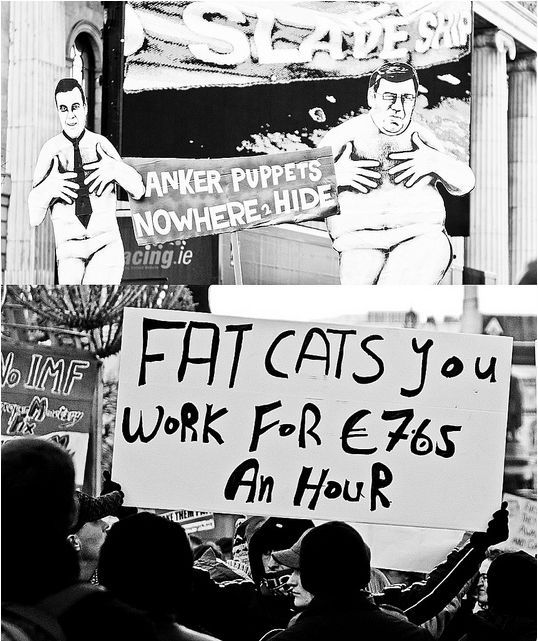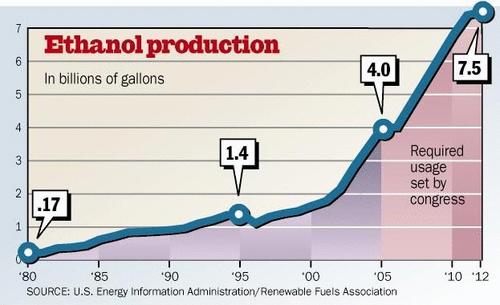We’ll analyze a proposal to fix the foreclosure mess put out by a DC think tank known as Third Way. Normally this blog steers clear of delving into random policy documents. In this case, though, it is likely that Third Way is speaking for the administration.
Third Way is an influential think tank whose board is composed of a special Wall Street-type – the Rubin Democrat. These people sit at the nexus of politics and finance, and are conduits for big bank friendly information flow into the administration and Congress. The President of the think tank, Jonathan Cowan, was the Chief of Staff for Andrew Cuomo at HUD in the 1990s, and Third Way is well known in policy circles for delivering ‘politically safe’ and well-packaged conventional wisdom. Oh, and one more thing – the new White House Chief of Staff Bill Daley, who just left the most senior operating committee of JP Morgan, was on their Board of Directors.
So by looking at this proposal, we are looking at the state of play among high level policy makers in DC, particularly of the New Dem bent. This is how the administration will probably try to play foreclosure-gate.
Their proposal, not surprisingly, is yet another bailout.
The big difference between the original and the new, improved version of the bailout model is that the payouts to the banks were at least in part visible the first time around. This is an effort yet again to spare the banks any pain, not only at the cost of the rule of law but also of investor rights.
This proposal guts state control of their own real estate law when the Supreme Court has repeatedly found that “dirt law” is not a Federal matter. It strips homeowners of their right to their day in court to preserve their contractual rights, namely, that only the proven mortgagee, and not a gangster, or in this case, bankster, can take possession of their home.
This sort of protection is fundamental to the operation of capitalism, so it’s astonishing to see neoliberals so willing to throw it under the bus to preserve the balance sheets of the TBTF banks. Readers may recall how we came to have this sort of legal protection in the first place. England learned the hard way in the 17th century what happens with low documentation requirements: abuse of court procedures, perjury and corruption become the norm. Parliament enacted the 1677 Statute of Fraudsto establish higher standards for contracts, such as witnessing by a third party, to stop the widespread theft of property that was underway.
The memo completely ignores the harm to investors from the bank mistakes and lacks any provisions for damage to investors to be remedied. Moreover, denying borrower rights removes their leverage to obtain deep principal mortgage modifications, which for viable borrowers produces lower losses than costly foreclosures and sales of distressed property. Thus this shredding of contractual protections in mortgages not only hurts borrowers but also harms investors.
So to save the banks from their own, colossal abuses of contracts that they devised, the Third Way document advocates Congressional intervention into well established, well functioning state law. This is a case where these matters can and should be left to the courts and ultimately state AGs to coordinate the template of a more broadbased solution.
But this proposal is this memo is a direct result of the banks losing in court and the fear that they will continue to lose. The Massachusetts Supreme Judicial Court Ibanez decision is clearly the trigger for the release of this plan. The SJC said its decision was merely articulating well established law. Consistent application of these principles will mean more losses for the banks. This memo is clearly an attempt to stop this as soon as possible. The real message of this document is clear: we can’t permit justice to prevail if it will hurt bank profits and balance sheets.
Let’s parse key sections of the document. Predictably, it chooses to divert attention away from the real issue, that of the greed and errors made by securitization industry participants, and the huge costs already imposed on innocent bystanders by the financial crisis.
Start with the first page:
While consumer advocates are hailing the decision as a victory for borrowers, homeowners are more likely to suffer the downsides—not the benefits—from the Massachusetts ruling. This case is certain to set off a massive wave of litigation by borrowers and lawyers eager to challenge a pending foreclosure. This in turn will create tremendous uncertainty in the still-wobbly housing market: Will homebuyers who bought a home out of foreclosure worry that their purchase will be invalidated? Will prospective homebuyers get too nervous to come off the sidelines, thereby driving up inventory and driving down home values? Will some homeowners be encouraged to “strategically default” in the hopes of winning a “free house” from technically faulty paperwork?
This is scare-mongering, pure and simple. It isn’t credible that a decision in one state with some idiosyncrasies in its real estate law will trigger a “massive wave of litigation”, particularly since anti-foreclosure lawyers often have trouble getting paid. Broke clients do not make for a great target market.
As to the “tremendous uncertainty” claim, where exactly has Third Way been? If they are only waking up now to the magnitude of the foreclosure mess, that alone disqualifies them from being competent to opine on this topic (note that this seems to reflect the advanced state of denial we’ve seen among securitization industry types; the result has been that parties further removed have been slow to wake up to the seriousness of this problem, despite ample evidence in local courts all over the US).
The homebuyer worry about foreclosure sales being invalidated argument is spurious; as we’ve remarked before, foreclosure sales are final. I can’t recall an instance of a public policy measure being implemented to pander to the neuroses of uninformed consumers.
Possible REO buyers sitting on the sidelines? That’s already true, and it’s due to doubts over validity of title thanks to MERS, not Mass., as well as the concern that housing has not bottomed in many markets. Since Third Way appears remarkably uninformed about housing market conditions outside the Beltway, namely, that there’s a huge inventory of homes yet to be foreclosed upon, largely due to servicers keeping borrowers in homes. That’s partly the result of a fee-maximizing “sweatbox” strategy, partly to save the costs of property maintenance and real estate taxes since they already have more real estate than they can unload in many local markets, and partly due court backlogs.
Third Way manages to accomplish the neat rhetorical trick of linking the urban-legend of “strategic defaults” (see Mike Konczal for details) with the jealousy-inciting “get a free house” meme.
Let’s get this straight: not a single lawyer I’ve come across want his client to get a free house. They fight foreclosures to get a mod. So when you see banks losing these cases, it’s because everyone involved on the servicer side has incentives to foreclose, not to modify loans.
In addition, vIrtually no decision, including Ibanez, have been “with prejudice”. That means the banks can foreclose if they get their act in gear. But the dirty secret is that the party that probably can foreclose is not the securitization trust, but an entity earlier in the securitization chain. Having someone other than the trust foreclose is a disaster for the securitization industry. There is no way to get the sale proceeds into the trust. The end result of having someone other than the securitization trust foreclose is to expose, as Georgetown Law professor has put it, that some if not most RMBS might actually be “non-mortgage-backed securities.”
We’ll largely skip over a heated and heavily spun section on the paper trail; it of course focuses on robosigning and overlooks numerous other abuses such as failure to convey notes properly and all too common document fabrications. However, we must note it too often gets the background and law wrong, again raising questions of basic competence. For instance:
Under the UCC, physical possession of the note and the mortgage are not required to enforce the loan.
This is embarrassing. The UCC is not relevant to this issue. As we have argued, the UCC (Article 1) specifically allows parties to contract out of the UCC and enter into more restrictive arrangements, which means the terms of the pooling and servicing agreement govern. But the UCC has nothing to do with the legal requirements for foreclosure; that’s governed by state-based real estate law, not the UCC. And in lien theory states, it means that the party foreclosing can be any of 1) “holder” of the note (meaning have possession AND be the proper party (or an agent of the proper party), 2) produce a lost note affidavit, 3) be subrogated to a holder or 4) be a purchaser from a holder who doesn’t yet have the note. Effectively, the foreclosing party either has to have the note or prove that it bought it from someone who actually has the note. That generally means you’ve got to produce the note.
The next section, on remedies, again contains distortions. For instance:
….if a foreclosure proceeding is otherwise justified (i.e. the borrower isn’t paying the loan), documentary failures don’t nullify a lender’s underlying right to a remedy.
Calling these “documentary failures” greatly understates the magnitude of the bank recklessness. A note is a negotiable instrument, like a check. Losing track of notes, each worth on average hundreds of thousands of dollars, is so deficient that that alone ought to justify all the major banks being seized and put through operational audits.
And despite this level of incompetence (or malfeasance), the banks have not been denied the ability to foreclose. Unless banks make repeated misrepresentations to the judge, the cases are dismissed without prejudice. The plaintiffs are free to come back and try again once they sort matters out. But they seldom bother. And again, it’s often because if they do find the note, it’s likely to be outside the trust, which as discussed above, creates a heap of other problems.
Next, in typical think tank style, the paper summarizes goals, then later offers remedies organized around those points; we’ll address both shortly.
The first goal is “Protecting injured homeowners“.
The discussion in the summary takes the view that the only “injured” homeowners that get any consideration are those “genuinely damaged by paperwork failures”. Thus the only problems that are addressed are screw-ups in the mod/short sale process and wrongful foreclosures. We see nary a mention of origination fraud or servicing abuses and errors. Yet foreclosure defense attorneys have said in 50% to 70% of the cases they represent, the borrower got in serious arrears as a result of servicing errors and compounding fees; a single late or misapplied payment can quickly compound into a multi thousand dollar deficiency before the borrower even finds out something is amiss.
Now let’s turn to the summary of section 2, “Keeping the housing market moving“:
The Massachusetts decision shouldn’t justify the creation of a cottage legal
industry aimed at stalling inevitable foreclosures. Creating a limited safe harbor from
paperwork-related litigation for pending foreclosures on abandoned or severely
delinquent properties would provide more certainty to the housing market and help
triage potentially successful modifications from inevitable foreclosures. In addition, a
one-year statute of limitations on paperwork-related lawsuits would ensure litigation
doesn’t drag on for years.
This is a doozy. “Cottage legal industry”? This is a more sophisticated, drive by version of the tactic used in a widely deplored first page Wall Street Journalstory which demonized foreclosure defense lawyers for being competent at court procedure.
Is there any other instance where an entire set of parties to a broad class of contract have gotten a free waiver for their own enormous, costly, and purely elective errors? The normal arrangement is that to obtain a waiver or a change in contract terms that has economic value, consideration must be paid. Remember the JP Morgan purchase of Bear: the reason the price went from $2 per share to $10 was that JPM had made a drafting error that left it exposed to more risk than it had bargained for and it needed to reopen the deal.
But I see no proposal here to have borrowers receive compensation from servicers and trustees for having their rights compromised. Aha, that’s the reason for all the expatiating about the Ibanez decision being bad for borrowers. They should give a major concession for free because it’s really good for them! Stockholm syndrome in action!
If the Third Way types were truly concerned about protecting homeowners rather than banks, they’d at the very least give homeowners something in return for the rights they are being asked to sacrifice, such as allowing courts to write down mortgages to current market value in bankruptcy (a well established practice for virtually every other type of secured lending).
Per the Third Way logic, the new reality of contracts is not the libertarian model of an agreement between equals, but of raw might makes right. A contract is treated as an ironclad, rigid arrangement if you are a small guy, but compliance is optional if you are powerful and well connected. Rubinites clearly benefit from promoting this world view.
And standing is NOT a matter of “paperwork”. This is a bedrock legal principle. Abandon the concept of legal standing, which is what this document calls for, and anyone can show up in court and say he has a right to your house once the statute of limitations has expired. Given that the initial foreclosure notice often lead to payment catch-up plans, combined with servicer incentives to keep borrowers in a delinquency “sweat box”, it isn’t hard to see servicers gaming a one-year statute of limitations (look how good a job they did of gaming the far more complicated HAMP).
In the detailed remedies section later in the document, Third Way picks up on a Shiela Bair proposal, that of a safe harbor against lawsuits if the house is vacant or the servicer has offered a deep payment mod, at least 25%. The vacancy provision looks like a red herring. How many cases are there where the house has been vacated, yet the borrower is suing? The only one I know of is not one that does not hew to the proposal’s assumptions about the motives of borrowers who do vacate property yet sue to get it back. The borrower left because she had previously been wrongly evicted from a rental, and everything in her apartment was dumped on the curb. By the time she got home from work, all her possessions, including her baby’s crib, had been stolen or hopelessly damaged. Economically and emotionally she could not afford to go through that again and moved out when the foreclosure became final (her attorney later filed a wrongful foreclosure suit).
More broadly, this element of the proposal appears unnecessary, and may give banks too much latitude in defining what is subject to this safe harbor.
As for Bair’s proposal for payment mods, the problem is that research shows again and again that what is called for is deep principal mods. Why should a borrower work to keep a deeply negative equity home only to face a shortfall upon sale?
Note that these provisions would also presumably have the effect of sheltering servicers and trustees from litigation, when the trustees made multiple certifications that they had all the loans and everything was in order. Remember, if the trustees had done what they repeatedly said in writing, in SEC filings, that they had done, none of this would be an issue.
Thus the Third Way plan also destroys contractual agreements without approval of the parties. Investors were entitled to get collateral with good title and, in the absence of that, to put back defective collateral to the seller. This would undo such contractual provisions for the sole benefit of one side, those on the originating/servicing end of the deal.
The next section, “Preventing future failures“, is motherhood and apple pie. The work is fobbed off to the Consumer Financial Protection Bureau, which in turn has to get approval from the members of the Financial Stability Oversight Council. Effectively, all the document calls for is for the CFPB to make sure banks live up to their contractual commitments. What a concept!
An ironic aspect of this proposal is that it is depicted as a way to reduce uncertainty. In fact, any Congressional intervention into well-settled state based real estate law is very likely to generate Constitutional challenges, particularly since Federal bank regulators have acknowledged that state law still applies to securitization assets. That in turn will increase, not reduce, uncertainty, and put the real estate market in an greater pall than it is now.
Finally, yet more “appease the banks” is a politically fraught strategy. The Administration seems unable to learn the real lesson of the midterm elections and is redoubling its efforts to pursue a failed course of action. Bank-friendly Blue Dog Democrats lost, progressives for the most part stayed in place, and Tea Partiers became a Congressional force for the first time. The unifying element is that this was a “vote out the corporatist incumbents” move above all else.
Establishment Republicans would also be wise to give this proposal a wide berth. If you want to recruit for the Tea Party, you could hardly find a better tool that to have the Federal government interfere with local courts on a matter as important to most Americans as their homes.











![[ROLLOVER]](http://si.wsj.net/public/resources/images/P1-AZ049_ROLLOV_NS_20110113202716.jpg)

![[ROLLOVERjp]](http://si.wsj.net/public/resources/images/P1-AZ044_ROLLOV_NS_20110113202714.jpg)




